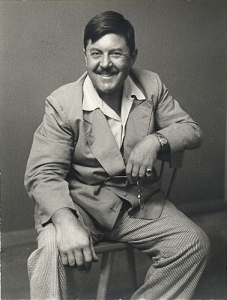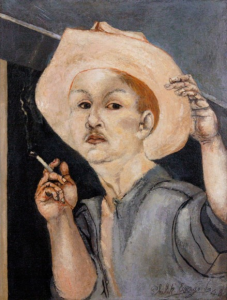

Biography
Philip Evergood led a turbulent life. He was born in New York to a Polish-Australian father Meyer Blashki and an English mother Flora Jan Perry. Their marriage had caused strains with their parents, since she was Anglican and he was Jewish. Philip studied music at an early age and was enrolled in the Ethical Culture School, which shaped his future social and political outlook. At age 7 he was giving piano concerts with his music teacher.
Flora wanted her son to have a proper English education and perhaps become a lawyer, so Philip was sent to English boarding schools, starting in 1909. He was denied admission to the Royal Naval Training College, probably because of anti-Semitism. This so angered Philip's father that he changed his name and that of his son from Blashki to Evergood (using a translation of his mother's maiden name, Immergut).
Philip went to Eton and then on to Cambridge, studying English literature, but this was obviously not his forte. With the help of his father, who was himself a landscape painter, Philip gained admission to the Slade School, where he studied with Henry Tonks, a renowned draftsman, and the sculptor James Havard Thomas.
Back in New York, Evergood enrolled at the Art Students League (1923-1925), where he studied with the Ashcan painter George Benjamin Luks and the Impressionist William von Schlegell. Fellow students included the etchers Philip Reisman and Harry Sternberg from whom Evergood learned something of the craft.
Evergood traveled to Europe from 1924-1926, studying at the Académie Julian in Paris with André Lhote and Jean-Paul Laurens. There he met the American dancer Julia Cross, whom he was to marry half a dozen years later. He returned to New York in 1926 when his mother was terminally ill. He himself had a severe illness at this time. But he also had his first one-man show at the Dudensing Gallery, which was critically well-received, if not financially rewarding. This show featured the biblical themes that Evergood had been developing, first in drawings and then in paintings. A second one-man show at the Montross Gallery in 1929 showed his transition to genre subjects.
Following a failed romance in 1929, Evergood went back to Paris, opened a studio and studied engraving with Stanley William Hayter at Atelier 17. He resumed his relationship with Julia Cross, and the couple traveled to Spain in 1931, giving Evergood the opportunity to study El Greco, Velasquez and Goya. Returning to New York, Cross and Evergood were married in Greenwich Village in 1931.
Evergood had a small one-man show at the Balzac Galleries in 1931. His work was included in the 1932 show "Murals by American Painters and Photographers" at the Museum of Modern Art in 1932. This was in the very depths of the Depression, and street scenes in New York made a deep impression on Evergood, turning his focus to the social issues so evident around him.
During this period Evergood's friends included John and Dolly Sloan, Ben Shahn, Hugo Gellert, Reginald Marsh, Chaim Gross, Yasuo Kinuyoshi, Moses Soyer and William Gropper. He became politically active, joining the John Reed Club for artists and writers and its counterpart, the Pierre Degeyter Club for musicians. Dolly and Julia were working at the Gallery of American Indian Art, which was run by Julia's mother. John Sloan facilitated an introduction of Evergood to the Whitney Museum of American Art, where his "Art on the Beach" was shown at the Whitney's Second Biennial.
In 1937 Evergood joined the American Contemporary Artists Gallery (ACA), a showplace for socially conscious art that had been founded by Herman Baron. ACA brought public recognition to such artists as Joe Jones, William Gropper, Robert Gwathmey, Moses Soyer, Anton Refregier and David Burliuk. Evergood held a one-man show at ACA in 1938. He also served as President of the Artists Union that year.
Evergood found employment with the Federal Art Project and painted a mural "The Story of Richmond Hill" (1937) for the Richmond Hill Library in Queens. Another federal commission came for the Jackson, GA Post Office, where he painted a mural "Cotton from Field to Mill" (1938). Nearly destitute, Evergood was working in a friend's frame shop, when the financier and art collector Joseph Hirshhorn walked in to pick up some paintings. Hirshhorn recognized Evergood's name, having seen his work at the Whitney, and he invited Evergood to show him a number of his canvases. This led to the purchase of 10 paintings, which allowed Evergood to quit his job at the frame shop and devote all his time to painting.
In 1940 Evergood was named artist in residence at Kalamazoo College in Kalamazoo, MI, where he completed a mural for the school's dining hall. Julia found Kalamazoo inhospitable for her dancing, and the couple returned to New York within a year. Following an illness in 1941, Evergood was ineligible for the draft into World War II. He had hoped to travel to North Africa to create pictorial records of the war, but he, Gropper and Refregier were all blackballed because of their political activism - or what the FBI quaintly called their "pre-mature anti-Fascism." Evergood did contribute paintings for a Russian War Relief calendar.
In 1945 Evergood made an intensive study of engraving, working with Stanley William Hayter, whose Atelier 17 had been relocated to New York during the war. In a bizarre incident, a policeman was murdered in Evergood's apartment during his absence, the killer having intended to kill Evergood himself. This so disoriented Evergood that he moved out of New York, first to Southbury, CT in 1952 and then to Bridgeport, CT in 1954. Julia remained in New York, and the couple lived separately until shortly before Evergood's death. The House Un-American Activities Committee interrogated Evergood and Ben Shahn in 1959. This had disastrous effects on Evergood's career. But in 1960 there was a major retrospective of Evergood's work at the Whitney Museum of American Art - with, however, a mixed critical reaction. Evergood's sponsor at ACA, Herman Baron, died in 1961, and the last years of Evergood's life were spent isolated from his wife and from the mainstream of American art, which had moved decisively into Abstract Expressionism. Evergood died in 1973, having suffered a heart attack while smoking in bed and being overcome by smoke from the resulting fire.


Critical Analysis
Some artists strive to show something; others find it more important to say something. Philip Evergood was decisively in the second category. He would have said that he was a painter with ideas to present and stories to tell. While his social circle in New York included many members of the Ashcan school, Evergood's work did not fall into this category. He felt that the Ashcan painters presented their down and out subjects as picturesque, while he was interested in their inner lives and their essential humanity. He contrasted his work with that of Reginald Marsh, saying "...Marsh's bums are 'classical', 'acceptable' bums, acceptable as lost souls and classical in their tragic hopelessness. My bums, which I painted at the same time as Marsh, were dangerous bums, discontented bums, because mine had not accepted their lot. Mine were not congenital bums, but transient bums."
Evergood's style also departed from that of the social realist painters. His figures were often intentionally clumsy, and his colors intentionally garish. The clumsy drawings had nothing to do with Evergood's abilities as a draftsman. Indeed he had spent nearly ten years doing nothing but drawing before he permitted himself the luxury of working with paint. And he described his color sense, saying that he always tried to use "the nasty color or sickly color, the sweet color or violent color or pretty-pretty-dolly color that will express the mood of what I’m trying to put over."
When Evergood started painting in the 1920s, his subjects were allegorical and biblical. But his life experiences in the 1930s pushed him toward social art and the view that "all good art is social art." Some of his paintings were violent, reflecting his own experience being beaten by the police after participating in a sit-in during the Depression. Yet his paintings often had a tender component. One can often find a family of birds flitting around the perimeter of a work by Evergood - an expression of the peace and freedom that he hoped mankind to find.
Murals
- Jackson, Georgia - Post Office: Cotton - From Field to Mill
- Richmond Hill, New York - Richmond Hill Public Library: The Story of Richmond Hill
References
- Family (Art of the Print).
- Amy Marie Adams, Get acquainted with Philip Evergood an artist of ideas, ARTists I like January 13 (2017).
- Oral history interview with Philip Evergood, 1968 Dec. 3 (Archives of American Art).
- Philip Evergood (Hirschl & Adler).
- Philip Evergood (Caldwell Gallery Hudson).
- Philip Evergood (Washington Color Gallery).
- Philip Evergood (Wikipedia).
- Philip Evergood (Forum Gallery).
- Philip Evergood, Art Design Café March 11 (2010).